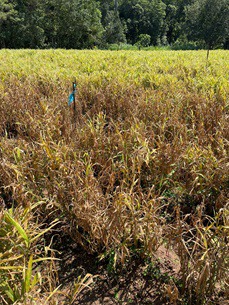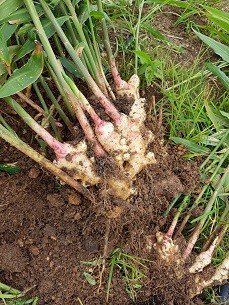 Three years ago, ginger farmers in northeastern South Africa and southern Mozambique simultaneously started noticing that the foliage in their ginger lands die off two months after planting, and by the time plants recover in April, three valuable growing months had been lost.
Three years ago, ginger farmers in northeastern South Africa and southern Mozambique simultaneously started noticing that the foliage in their ginger lands die off two months after planting, and by the time plants recover in April, three valuable growing months had been lost.
Right: infected ginger lands during the past season
A fungus completely new to growers is responsible. Its provenance remains unclear and current fungicides aren’t able to fully manage the problem, says Wiekus Prins, AECI chemical crop advisor in Kiepersol, Mpumalanga.
"We have no answers"
As a result of the fungus, some established ginger growers took the decision to plant no ginger last year. “We have no answers currently,” remarks a farmer who asks to remain anonymous. “We absolutely hope to continue growing ginger, but at the moment we’re not even sure what exactly we’re facing.”
Joachim Prinsloo of Sunreaped Farm in Kiepersol remarks that they're aware that many farmers had lost their entire ginger crops to this fungus. They were not themselves affected by this fungus, but even so, he notes, it had been a difficult year to grow ginger. "It's never easy to farm ginger, but as a result of healthy farming practices we came out the other side and still had a good crop."
Wiekus Prins explains: “The rhizome itself is not affected but farmers lose a massive amount of tonnages per hectare because of the fungus. It reared its head three years ago and rapidly expanded across South Africa’s ginger production areas like Kiepersol, Hazyview, Levubu, and I know of two ginger farmers in Mozambique who are also affected to varying degrees.” It is a major dilemma for South Africa’s small ginger industry, but chemical companies don’t want to incur the costs to register new products because it is such a small industry.
It is a major dilemma for South Africa’s small ginger industry, but chemical companies don’t want to incur the costs to register new products because it is such a small industry.
Right: a healthy ginger rhizome
Ginger prices are always high this time of the year (during Covid, new ginger farmers mushroomed to take advantage of high ginger prices).
The first vessels with Chinese ginger depart at the end of January and then prices decline steadily until the South African ginger harvest from May to August.
Acute shortage of ginger planting material
Ginger propagation is fairly unregulated in South Africa. Farmers conduct informal trials of planting material, selecting strains that were least affected by the unknown fungus for the next season.
“Farmers are on their own,” Prins remarks. “The Agricultural Research Council isn’t conducting any research on ginger anymore.”
There is an acute shortage of ginger rhizomes; the price generally follows the market price for fresh ginger.
Ginger is one of the most difficult and most expensive crops to farm, observes the ginger farmer.
“When you take a knock, it’s a hard one. The ginger industry has always been a tumultuous industry, except that pests weren’t this out of control.”
For more information:
Wiekus Prins
AECI
Tel: +27 11 806 8700
https://ic.aecichemicals.co.za/
Joachim Prinsloo
Sunreaped
Tel: +27 76 123 0035
